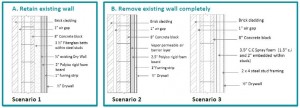
Energy efficiency in existing buildings is most often addressed by upgrading outdated lighting equipment and adding efficient equipment to the heating and cooling systems because of low risk and short financial payback.
Building wall energy retrofits are rarely undertaken because of high up-front cost (lengthy payback periods) and perceived higher risk.
Thermal heat gain, through commercial building walls, and building infiltration account for significant primary energy use (2.77 quads).
The building envelope and energy systems complement each other. Wall sealing and insulation significantly reduce thermal load on a building, reducing HVAC system size requirements and operating costs.
A 15 year or less payback for wall sealing and insulation is deemed a good financial target for scalability when coupled with HVAC equipment right sizing.
A cost-effective retrofit wall insulation and sealing solution is in the process of being identified that will provide a potentially scalable performance and payback period.
After field testing the selected solution(s) and assessing the results, a retrofit best practices guide will be created and disseminated throughout the industry.
Date: April 09, 2015